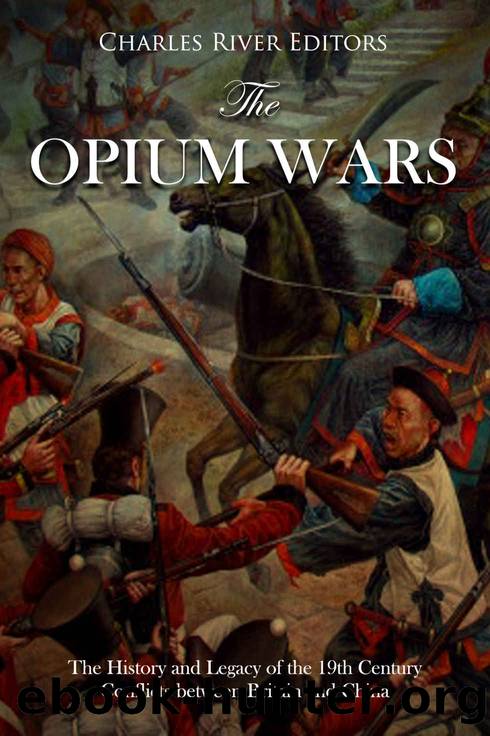The Opium Wars: The History and Legacy of the 19th Century Conflicts between Britain and China by Charles River Editors

Author:Charles River Editors
Language: eng
Format: epub
Publisher: Charles River Editors
Published: 2018-05-02T00:00:00+00:00
A depiction of the British capture of Chusan
The British stalled at Tinghai, as the delayed arrival of the expeditionary force, coupled with the hefty displacement of the forceâs largest warships, slowed the fleetâs advance to Peking.[cxxxvii] Taking the time needed to tow the larger vessels through the islandâs shallower waters, the fleet resumed heading for Peking on August 1.[cxxxviii]
Recognizing the dangers in attempting to conquer the heavily defended capital, the fleet, upon nearing the city, started by negotiating, delivering a letter meant for the Emperor to the regionâs Viceroy.[cxxxix] The letter was given and received courteously, though internally the Viceroy no doubt felt a great deal of panic at the situation. Chinaâs elite were northerners who had conquered the Empire, ruling as a minority amongst a mass of peasants. The upheaval the foreignerâs presence foretold could upset that balance and cause a civil war. The Viceroyâs goal was to keep the British as close to Canton as possible, while giving as few concessions as their military advantages allowed.[cxl]
The bulk of the letter contained complaints against Lin. The letter, coming from Lord Palmerston, arrived in Peking on the same day as a letter from the Governor-General himself. The Emperor quickly sent for Lin, demanding upon his arrival in Peking to explain himself.[cxli] Canton itself, officially under blockade, remained a hotbed of smuggling activity, its new Governor-General as ineffective at fully stopping the trade as the British blockade. Back in Peking, Lin advocated for modernization, realizing it was the only way to halt the foreignerâs advances.[cxlii]
Time passed in a stalemate, the British awaiting their demands to be met and the Chinese playing for time. Elliot, his fuse exhausted as 1840 turned to 1841, declared that if concessions were not offered by January 5, the British would resume hostilities. The Viceroy, unaware of the true devastation of the Royal Navyâs might, remained unconvinced. In response, the British sought to demonstrate their might by destroying the outlying forts.[cxliii]
3,000 entrenched men flanked by field batteries lay between the British and the forts. The British plan called for sending around fourteen hundred troops, divided into two divisions with field pieces, under cover of the shipâs batteries, to dislodge the Chinese.[cxliv] The assault began at 9:30 in the morning with an opening salvo from the British. Hauling the field pieces through the winter mud turned out to be the most difficult part of the landing itself.[cxlv] The forts, defended by elite Tartar troops, quickly found themselves caught in a pincer by enemy soldiers with blood in their eyes. In two and a half hours of brutal fighting, the first Chinese flag fell.[cxlvi] The Tartars suffered 600 dead and 100 captured; British casualties, thanks to an accidental explosion, amounted to thirty wounded.[cxlvii]
Having secured the land objective, the British proceeded to set fire to eleven junks with a flurry of Congreve rockets.[cxlviii] Another fort was laid to waist, in response to which the Chinese arranged a three-day truce in order for the local commander to confer with the civilian authorities regarding their next course of action.
Download
This site does not store any files on its server. We only index and link to content provided by other sites. Please contact the content providers to delete copyright contents if any and email us, we'll remove relevant links or contents immediately.
| Central Asia | Southeast Asia |
| China | Hong Kong |
| India | Japan |
| Korea | Pakistan |
| Philippines | Russia |
The Rape of Nanking by Iris Chang(3531)
The Sympathizer by Viet Thanh Nguyen(3528)
World without end by Ken Follett(3016)
Ants Among Elephants by Sujatha Gidla(2932)
Blood and Sand by Alex Von Tunzelmann(2615)
Japanese Design by Patricia J. Graham(2565)
City of Djinns: a year in Delhi by William Dalrymple(2140)
Inglorious Empire by Shashi Tharoor(2108)
In Order to Live: A North Korean Girl's Journey to Freedom by Yeonmi Park(2064)
Foreign Devils on the Silk Road: The Search for the Lost Treasures of Central Asia by Peter Hopkirk(2061)
Tokyo by Rob Goss(2025)
India's Ancient Past by R.S. Sharma(1994)
India's biggest cover-up by Dhar Anuj(1992)
The Great Game: On Secret Service in High Asia by Peter Hopkirk(1965)
Tokyo Geek's Guide: Manga, Anime, Gaming, Cosplay, Toys, Idols & More - The Ultimate Guide to Japan's Otaku Culture by Simone Gianni(1953)
Goodbye Madame Butterfly(1942)
The Queen of Nothing by Holly Black(1770)
Living Silence in Burma by Christina Fink(1738)
Batik by Rudolf Smend(1726)
